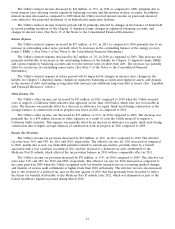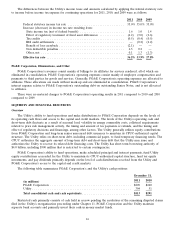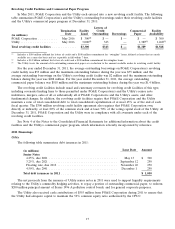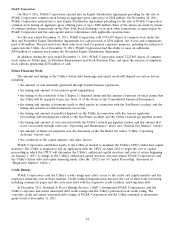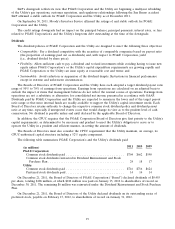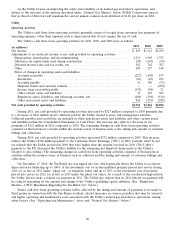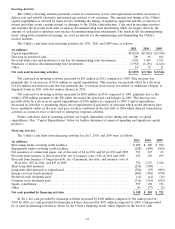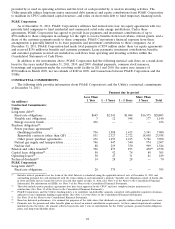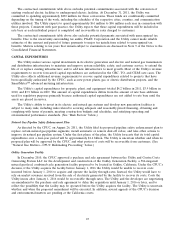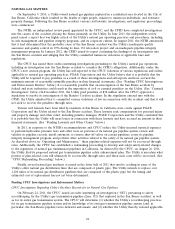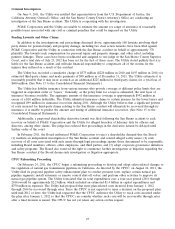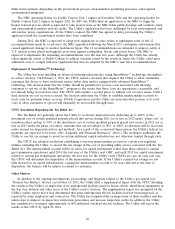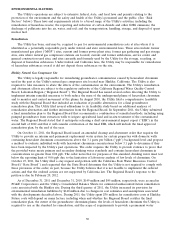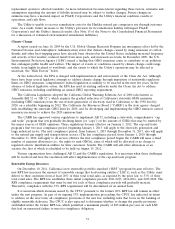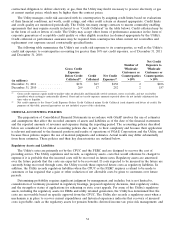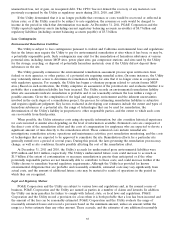PG&E 2011 Annual Report Download - page 29
Download and view the complete annual report
Please find page 29 of the 2011 PG&E annual report below. You can navigate through the pages in the report by either clicking on the pages listed below, or by using the keyword search tool below to find specific information within the annual report.law and safety standards. Among other matters, this phase will determine whether the San Bruno accident would
have been preventable by the exercise of safe procedures and/or accurate and effective technical recordkeeping in
compliance with the law. The CPUC will consider whether the Utility’s approach to recordkeeping stems from
corporate-level management policies and practices and, if so, whether such practices and policies contributed to
recordkeeping violations that adversely affected safety. The CPSD is scheduled to file its report on the Utility’s
recordkeeping practices on March 5, 2012. Evidentiary hearings for the investigation are scheduled for September
2012 with a final decision expected in February 2013. See ‘‘Penalties Conclusion’’ below.
CPUC Investigation Regarding Class Location Designations for Pipelines
On November 10, 2011, the CPUC issued an OII pertaining to the Utility’s operation of its natural gas
transmission pipeline system in or near locations of higher population density. Under federal and state regulations,
the class location designation of a pipeline is based on the types of buildings, population density, or level of human
activity near the segment of pipeline, and is used to determine the maximum allowable operating pressure
(‘‘MAOP’’) up to which a pipeline can be operated. In the OII, the CPUC referred to the Utility’s June 30, 2011
class location study, in which the Utility reported that the class designations for some of its transmission pipeline
segments had changed from what was reflected in the Utility’s Geographical Information System (‘‘GIS’’). Among
other issues, the CPUC will determine whether the Utility failed to conduct class location studies when required,
failed to adequately patrol and conduct continuing surveillance of its pipeline transmission system, failed to replace
pipeline segments or reduce MAOP when the class location designation of a segment changed, and failed to furnish
and maintain adequate, efficient, just and reasonable natural gas transmission service.
On January 17, 2012, in its response to the OII, the Utility provided further information about the classification
of its transmission pipeline segments. The Utility reported that 162 miles of pipeline had a current class location
designation that was higher than reflected in its GIS. Most of the misclassifications were attributable to the Utility’s
failure to correctly identify development or well-defined areas near the pipeline. The Utility determined that some
segments had been incorrectly classified since 1971. The Utility also determined that it had not timely performed a
class location study for certain segments and did not confirm the MAOP of those segments for which the Utility had
not timely identified a change in class location. On February 2, 2012, the Utility filed an update reporting that
approximately 10 miles had been operating at a MAOP higher than allowed for their current class location.
A prehearing conference was held on February 3, 2012 at which the assigned administrative law judge (‘‘ALJ’’)
set April 2, 2012 as the date for the Utility to report the final results of its validation of the class location data. The
ALJ will set a second prehearing conference during the week of April 16, 2012 to address the scope and procedural
schedule of the proceeding, including the date of an evidentiary hearing. See ‘‘Penalties Conclusion’’ below.
CPUC Investigation Regarding San Bruno Accident
On January 12, 2012, the CPUC issued an OII to determine whether the Utility violated applicable laws, rules,
orders, requirements, and industry safety standards in connection with the San Bruno accident. The CPUC stated
that the scope of the investigation will include all past operations, practices and other events or courses of conduct
that could have led to or contributed to the San Bruno accident, as well as, the Utility’s compliance with CPUC
orders and resolutions issued since the date of the San Bruno accident.
The CPUC cited the findings and allegations made by the CPSD in its investigative report released on
January 12, 2012. In its report, the CPSD alleged that the San Bruno accident was caused by the Utility’s failure to
follow accepted industry practice when installing the section of pipe that failed, the Utility’s failure to comply with
federal pipeline integrity management requirements, the Utility’s inadequate record keeping practices, deficiencies in
the Utility’s data collection and reporting system, inadequate procedures to handle emergencies and abnormal
conditions, the Utility’s deficient emergency response actions after the incident, and a systemic failure of the Utility’s
corporate culture that emphasized profits over safety. The CPUC noted that the CPSD’s investigation is ongoing and
that the CPSD could raise additional concerns for the CPUC to consider.
The CPSD report also discussed the findings of an independent consulting firm engaged by the CPUC to
conduct an audit of the Utility’s natural gas transmission and storage expenditures from 1996 to 2010. The CPSD
report stated that the purpose of the audit was to determine whether the amounts that the CPUC authorized for gas
pipeline safety investments were actually spent on safety investments. The CPSD made various recommendations
based on its allegations and the findings in the consultant’s audit report. During this time, the consultant’s audit
report alleged that the Utility spent less on capital expenditures and operation and maintenance expense than it
recovered in rates, by $95 million and $39 million, respectively, and alleged that the Utility collected $430 million
25


